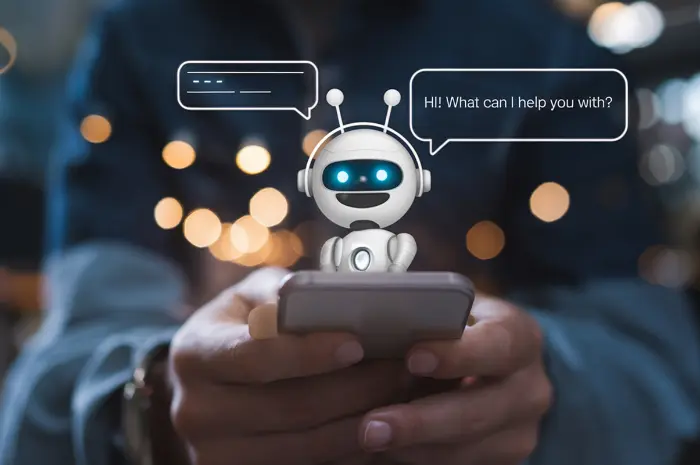Once confined to simple rule-based interactions, enterprise chatbots have transformed into intelligent, context-aware assistants. Powered by AI technologies like large language models (LLMs) and hybrid architectures, today’s chatbots serve as both customer champions and internal productivity engines. Leaders now ask not “should we use chatbots?” but rather, “how do we develop enterprise AI chatbot and deploy them strategically, ethically, and at scale?”
Strategic Value: Why Enterprise AI Chatbots Matter

1. Elevated Customer Experience
AI chatbots now offer 24/7 availability, instantly resolving queries and maintaining brand consistency. Take the example of Max Life Insurance, whose Dialogflow chatbot doubled customer satisfaction and handled thousands of interactions per month. These bots scale support without ramping up headcount- an efficiency game-changer.
2. Operational Efficiency
Routine tasks like FAQs, transaction status, and reset requests can now be offloaded to bots. This reduces operational costs and frees human agents for high-value interactions. Moreover, each chat interaction captures valuable feedback- enabling businesses to improve offerings and messaging.
3. Empowered Employees
Moveworks’ intelligent assistant, now part of ServiceNow, demonstrates how AI bots can streamline internal operations- handling IT tickets, HR queries, and report generation. These assistants scale internal support and make employees more self-sufficient.
Technical Foundations That Power Modern Chatbots

- Deep NLP and NLU: Intent detection, entity extraction, sentiment analysis, and transformer models (like BERT or GPT) allow bots to understand nuanced user input.
- Dialogue Management: Most systems now combine rule-based flows with neural components- balancing predictability and flexibility through hybrid approaches.
- Response Generation: Bots often interleave templated replies (for compliance) with LLM-generated responses for naturalness. Enterprises layer in validation and moderation to avoid inaccuracies.
Model Fine-Tuning & Feedback Loops
Chat logs, labeled data, and performance metrics are used to continuously refine responses. A recent IBM blog on building RAG-based chatbots highlights how retrieval-augmented generation ensures accuracy and relevance.
Architecture & Design: How Enterprise Bots Are Built

Modular Architecture
Chatbot systems are now built like microservices- separate modules for NLU, dialogue flow, integrations, security, and analytics. This modular approach improves scaling and agility.
Multi-Channel Presence
Bots seamlessly deploy across web, mobile, voice platforms, and messaging tools like Slack or Teams. Consistent, cross-channel context retention is key to user continuity.
Human-AI Collaboration
Bots escalate complex queries to humans while preserving chat context. This critical design avoids frustration and ensures accountability.
Personalization by Design
CRM integration enables bots to personalize interactions- greeting users by name, referencing past transactions, and adapting tone and suggestions over time.
Security and Compliance
Encryption, role-based access, data protection, and regulatory compliance (GDPR, HIPAA, etc.) are foundational. Platforms like IBM’s WatsonX add extra governance and privacy controls.
Also Read: Chatbot Development Guide: Things to Consider, Types, and Cost-Benefit Analysis
Ecosystem Integration: Chatbots as Action-Oriented Platforms
![]()
Integrating with Backend Systems
Chatbots interact with CRM (like Salesforce), ERP (SAP, Oracle), ticketing, and knowledge bases to do more than talk- they act. Agents can initiate orders, create tickets, provide real-time status, and more.
Orchestration with RPA
Robotic Process Automation tools help bots trigger workflows like fraud checks or data retrieval. Together, bots and RPA drive end-to-end automation without UI constraints.
Analytics & Continual Improvement
Performance dashboards track engagement, containment, fallback rates, and satisfaction. Feedback loops inform training and optimization.
Success Metrics: What Defines a Winning Chatbot?

- Containment Rate: Percentage of sessions handled without human intervention
- Task Completion Rate: Ability to fulfill user goals (like bookings or order status)
- CSAT / Customer Satisfaction: Direct user ratings on helpfulness
- Response & Resolution Time: Speed and efficiency of interactions
- Cost Savings: Reduction in live-agent dependency
- Accuracy & Precision: Especially in factual, data-driven responses
Principles of Ethical, Responsible AI Deployment
![]()
- Transparency: Always declare that users are interacting with AI- not a human. Transparency builds user trust.
- Bias Mitigation: Ensure diverse, polished training data. Regular audits prevent skewed or insensitive responses. Research on bias in chatbots highlights these risks and mitigation strategies.
- Privacy-Controlled Design: Only retain necessary logs, manage consent, and enable data deletion. This is critical in regulated industries.
- Safe Use Clauses: For sensitive content, provide disclaimers or a human fallback (“Please confirm this information with your healthcare provider”).
Challenges & Practical Best Practices

- Expectation Management: Start with specific, high-value use cases. Incrementally scale based on data and feedback.
- Data Quality Emphasis: Clean and annotate data. Bring in domain experts for intent and entity mapping.
- Combatting Hallucinations: Use retrieval-augmented generation (RAG) with grounded knowledge sources. Monitor hallucination rates closely.
- Localization Complexity: Design for multilingual understanding and localized content- not just translations.
- Scalability & Reliability: Leverage cloud autoscaling, redundancy, and load balancing for resilience during spikes.
Future Trends Shaping Chatbots in 2025 and Beyond
- Generative & Multimodal AI: Bots handling voice, text, and visual inputs
- Proactive AI Agents: Chatbots that initiate actions (like reminders or follow-ups)
- Lean Domain-Specific LLMs: Smaller models fine-tuned for finance, healthcare, etc., delivering faster inference and reduced bias
- Built-in Compliance Platforms: AI deployment with automatic bias-checks, governance, and audit trails
- Emotionally Intelligent Bots: Bots detecting user sentiment and adjusting tone or escalating when needed
Real-World Practices Backed by Top Enterprises

When it comes to enterprise adoption, IBM has been setting benchmarks with both research and real-world applications of AI chatbots. In its “2025 Trends for AI Chatbots” webinar, IBM highlights a major industry shift: AI agents are no longer just reactive support tools; they are becoming proactive partners that drive productivity through inference, automation of routine tasks, and seamless integration with business workflows.
Central to this vision is IBM’s Watsonx platform, which provides enterprises with an end-to-end suite for model training, deployment, monitoring, and governance. This unified approach ensures not only speed and efficiency in bringing AI solutions to market but also accountability, compliance, and trust- critical factors for organizations operating in regulated industries.
On its “Chatbot Examples” page, IBM translates thought leadership into actionable guidance. It shares best practices such as defining clear goals for chatbot initiatives, segmenting user groups to tailor interactions, conducting rigorous testing to ensure reliability, and building fallback planning mechanisms so conversations remain useful even when AI encounters limitations. These principles serve as a practical blueprint that any enterprise can adopt to maximize chatbot effectiveness while minimizing risks.
By combining visionary insights with field-tested recommendations, IBM demonstrates how structured strategies and governance frameworks can transform chatbot projects from pilot experiments into scalable, business-critical assets.
Conclusion
Enterprise AI chatbots have evolved from novelty to mission-critical. They now drive customer engagement, internal efficiency, and strategic automation. With thoughtful design, hybrid architectures, responsible AI practices, and clear ROI tracking, they unlock transformative value.
In 2025 and beyond, chatbots will act as proactive assistants- empathic, context-driven, and deeply integrated with enterprise systems. They promise not just automation but an entirely new conversational interface, reshaping how businesses operate.







